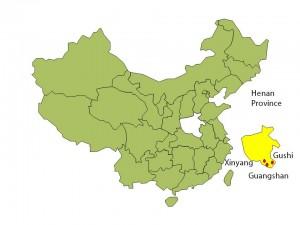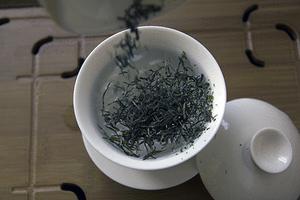In 1987, archaeologist found tea leaves in a tomb in Xinyang, Henan. It was dated more than 2,300 years old, establishing the millennia old existence of tea in Xinyang. Yet for all its longevity and illustrious history, as recent as the late 19th century, Xinyang tea barely registered a blip on the tea map.
How did this renowned tea producing region raise itself from the doldrums to produce Xinyang Maojian- one of the best known Chinese green teas?
But before we get to the current splendor, let’s dwell a bit on Xinyang’s past glory.
Tang & Song Dynasty

In addition, Huainan where Yiyang (former Xinyang) was demarcated was one of the most important of the 8 tea producing regions recorded by the sage of tea, Lu Yu in his Classics of Tea aka Cha Jing.
During the Song Dynasty, the fame of Xinyang- as it was then christened- only grew. One of the most oft quoted tea lovers, scholar Su Shi- or better known by his moniker Su Dong Po- once said “Of Huainan’s Teas, Xinyang is the best”.
It was recounted that Su Dong Po’s utterance was literally inspired by royalty. At that time, he was a favorite official (that he later was sent into exile only goes to show how fickle monarchs can be but I digress) of the Emperor and once a trusted servant of the Emperor sought him furtively. He was given a small sachet that the servant said was issued under the Emperor’s instructions. Inside was Xinyang tea. Naturally if an Emperor deigns to give you a particular type of tea, it must be exceptional.
Qing Dynasty
Apart from Lu Yu and Su Dong Po, another oft quoted tea fanatic is Emperor Qian Long of the Qing Dynasty. What did Qian Long have to say about Xinyang teas?

In fact, virtually none of the Qing Dynasty literature mentioned Xinyang. This was even more of an anomaly given how tea thrived during the Qing Dynasty.
But while tea thrived elsewhere, notably Zhejiang, Anhui and Fujian, Xinyang tea production fell on hard times during the Qing Dynasty. High taxes and natural disaster resulted in many former tea farmers abandoning it in favor of subsistence farming.
This former proud tea producing region soon all but abandoned widespread tea production.
Rebirth
This situation persisted until the turn of the 20th century when a scholar by the name of Gan Yi Jing returned to his hometown at age 37 in 1903. This scholar soon turned entrepreneur- probably inspired by the lack of prospects in the civil service considering the state the Qing Dynasty was in- and gathered some of his fellow villagers to revive tea production in Xinyang.
It was not an overnight success but with Gan did manage to inspire a new generation of merchants. In 1913, the first Xinyang brand was established- Che Yun Long Jing. It was so named as it was produced by tea leaves grown from the seedlings of Hangzhou’s Longjing tea aka Dragon Well and grown in Che Yun Mountain, currently the most reputable Xinyang tea mountain.
It was not a direct imitation though. The Che Yun Long Jing incorporated elements of Longjing and Liuan Guapian production. The tea leaves are wok-roasted AND baked dried to give it its distinctive taste.
International Recognition
In 1915, this tea burst on the international scene at the Panama Tea Expo and subsequently it was renamed and rebranded Xinyang Maojian, a name that had been coined earlier but never gained popularity then.
The name Xinyang Maojian sounds a little odd- Xinyang Furry Tips. It is so named after the ‘downy fur’ aka ‘pekoe’ of the leaves and the tippy shape that the leaves are in.

Whichever the case, the name stuck thereafter.
Global domination didn’t ensue but through no fault of its own. The newly established republic was then plagued with decades of external invasion from the Japanese and later the Chinese civil war.
Fortunately for tea lovers, Xinyang was not buried a second time and after the People’s Republic of China was born- notwithstanding the tumultuous years of the Great Leap Forward and the Cultural Revolution- Xinyang Maojian thrived.
Today it is on numerous renditions of China’s Top 10 Famous Teas and probably is the 4th best known Chinese green tea after Xihu Longjing, Dongting Biluochun and Huangshan Maofeng.
Not bad for a tea producing region that was forgotten for centuries.
Try Xinyang Maojian in our stores.
